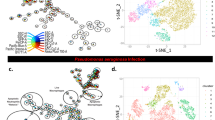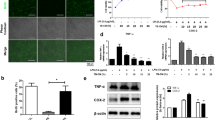Abstract
Background
Chronic otitis media with effusion (COME) is characterized by persistent middle ear effusions that are in most cases highly viscous, but some patients present with serous fluid. This study aimed at comprehensively characterizing the macromolecular composition of mucoid vs. serous middle ear effusions (MEEs).
Methods
MEEs from patients with COME were analyzed for proteins by mass spectrometry (MS) and western blot techniques, total DNA quantity, bacterial DNA (16S sequencing), and cytokine content. Proteomics datasets were studied in Ingenuity Pathway Analysis (IPA).
Results
Mucoid samples showed a global tendency of increased pro-inflammatory mediators. Interleukin-1β (IL-1β) and IL-10 were significantly more abundant in serous samples (p < 0.01). Mucoid samples had higher DNA quantity (p = 0.04), more likely to be positive in MUC5B protein (p = 0.008) and higher peptide counts (12,786 vs. 2225), as well as an overall larger number of identified proteins (331 vs. 177), compared to serous. IPA found the mucoid sample dataset to be related to immune cell function and epithelial remodeling, whereas the serous sample dataset showed acute responses and blood-related proteins. Interestingly, serous samples showed more bacterial DNA than mucoid ones, with less bacterial genera variability.
Conclusion
This study demonstrates divergent immune responses in children with COME by effusion quality.
Similar content being viewed by others
Log in or create a free account to read this content
Gain free access to this article, as well as selected content from this journal and more on nature.com
or
References
Cherry D.K., Woodwell D. A. National Ambulatory Medical Care Survey: 2000 Summary. Advance Data From Vital and Health Statistics No. 328. Hyattsville, MD: National Center for Health Statistics; 2002.
Grubb, M. S. & Spaugh, D. C. Treatment failure, recurrence, and antibiotic prescription rates for different acute otitis media treatment methods. Clin. Pediatr. (Phila.) 49, 970–975 (2010).
Rosenfeld, R. M., Casselbrant, M. L. & Hannley, M. T. Implications of the AHRQ evidence report on acute otitis media. Otolaryngol. Head Neck Surg. 125, 440–448 (2001). discussion 439.
Ahmed, S., Shapiro, N. L. & Bhattacharyya, N. Incremental health care utilization and costs for acute otitis media in children. Laryngoscope 124, 301–305 (2014).
Brugnara, L. et al. Low physical activity and its association with diabetes and other cardiovascular risk factors: a Nationwide, Population-Based Study. PLoS ONE 11, e0160959 (2016).
Leidinger, P. et al. Differential blood-based diagnosis between benign prostatic hyperplasia and prostate cancer: miRNA as source for biomarkers independent of PSA level, Gleason score, or TNM status. Tumour Biol. 37, 10177–10185 (2016).
Lim, D. J. & Birck, H. Ultrastructural pathology of the middle ear mucosa in serous otitis media. Ann. Otol. Rhinol. Laryngol. 80, 838–853 (1971).
Tos, M. & Bak-Pedersen, K. Goblet cell population in the pathological middle ear and eustachian tube of children and adults. Ann. Otol. Rhinol. Laryngol. 86, 209–218 (1977).
Ryan, A. F. et al. Recent advances in otitis media. 4A. Molecular biology. Ann. Otol. Rhinol. Laryngol. Suppl. 194, 42–49 (2005).
Hurst, D. S. & Venge, P. The impact of atopy on neutrophil activity in middle ear effusion from children and adults with chronic otitis media. Arch. Otolaryngol. Head. Neck Surg. 128, 561–566 (2002).
Val, S. et al. Proteomic characterization of middle ear fluid confirms neutrophil extracellular traps as a predominant innate immune response in chronic otitis media. PLoS ONE 11, e0152865 (2016).
King, L. B. et al. Observation of viable nontypeable haemophilus influenzae bacteria within neutrophil extracellular traps in clinical samples from chronic otitis media. Otolaryngology 3, 145 (2013).
Thornton, R. B. et al. Neutrophil extracellular traps and bacterial biofilms in middle ear effusion of children with recurrent acute otitis media—a potential treatment target. PLoS ONE 8, e53837 (2013).
Preciado, D. et al. MUC5B is the predominant mucin glycoprotein in chronic otitis media fluid. Pediatr. Res. 68, 231–236 (2010).
Val, S. in Otitis Media: State of the Art Concepts and Treatment (editor Diego Preciado) 53–79 (Springer, Berlin, 2015).
Kubba, H., Pearson, J. P. & Birchall, J. P. The aetiology of otitis media with effusion: a review. Clin. Otolaryngol. Allied Sci. 25, 181–194 (2000).
Dodson, K. M., Cohen, R. S. & Rubin, B. K. Middle ear fluid characteristics in pediatric otitis media with effusion. Int. J. Pediatr. Otorhinolaryngol. 76, 1806–1809 (2012).
Matkovic, S., Vojvodic, D. & Baljosevic, I. Cytokine levels in groups of patients with different duration of chronic secretory otitis. Eur. Arch. Otorhinolaryngol. 264, 1283–1287 (2007).
Kawano, H. et al. Identification of MUC5B mucin gene in human middle ear with chronic otitis media. Laryngoscope 110, 668–673 (2000).
Lin, J. et al. Expression of mucins in mucoid otitis media. J. Assoc. Res. Otolaryngol. 4, 384–393 (2003).
Lin, J. et al. Characterization of mucins in human middle ear and eustachian tube. Am. J. Physiol. Lung Cell. Mol. Physiol. 280, L1157–L1167 (2001).
Chung, M. H. et al. Compositional difference in middle ear effusion: mucous versus serous. Laryngoscope 112, 152–155 (2002).
Elsheikh, M. N. & Mahfouz, M. E. Up-regulation of MUC5AC and MUC5B mucin genes in nasopharyngeal respiratory mucosa and selective up-regulation of MUC5B in middle ear in pediatric otitis media with effusion. Laryngoscope 116, 365–369 (2006).
Ubell, M. L. et al. MUC2 expression in human middle ear epithelium of patients with otitis media. Arch. Otolaryngol. Head Neck Surg. 134, 39–44 (2008).
Radicioni, G. et al. The innate immune properties of airway mucosal surfaces are regulated by dynamic interactions between mucins and interacting proteins: the mucin interactome. Mucosal Immunol. 9, 1442–1454 (2016).
Krueger, A. et al. Relationship of the middle ear effusion microbiome to secretory mucin production in pediatric patients with chronic otitis media. Pediatr. Infect. Dis. J. 36, 635–640 (2017).
Rose, M. C. & Voynow, J. A. Respiratory tract mucin genes and mucin glycoproteins in health and disease. Physiol. Rev. 86, 245–278 (2006).
Val, S. et al. Middle ear response of Muc5ac and Muc5b mucins to nontypeable Haemophilus influenzae. JAMA Otolaryngol. Head Neck Surg. 141, 997–1005 (2015).
Chen, R. et al. Nontypeable Haemophilus influenzae lipoprotein P6 induces MUC5AC mucin transcription via TLR2-TAK1-dependent p38 MAPK-AP1 and IKKbeta-IkappaBalpha-NF-kappaB signaling pathways. Biochem. Biophys. Res. Commun. 324, 1087–1094 (2004).
Kim, Y. T. et al. Up-regulation of MUC5AC mRNA expression in endotoxin-induced otitis media. Acta Otolaryngol. 121, 364–370 (2001).
Song, K. S. et al. Interleukin-1 beta and tumor necrosis factor-alpha induce MUC5AC overexpression through a mechanism involving ERK/p38 mitogen-activated protein kinases-MSK1-CREB activation in human airway epithelial cells. J. Biol. Chem. 278, 23243–23250 (2003).
Sade, J. Pathology and pathogenesis of serous otitis media. Arch. Otolaryngol. 84, 297–305 (1966).
Ol’shanskaia, Iu. V. et al. [Chromosomal aberrations in myelodysplastic syndrome]. Ter. Arkh. 77, 27–33 (2005).
Tos, M. & Caye-Thomasen, P. Mucous glands in the middle ear—what is known and what is not. ORL J. Otorhinolaryngol. Relat. Spec. 64, 86–94 (2002).
Fujisawa, T. et al. NF-kappaB mediates IL-1beta- and IL-17A-induced MUC5B expression in airway epithelial cells. Am. J. Respir. Cell Mol. Biol. 45, 246–252 (2011).
Bautista, M. V. et al. IL-8 regulates mucin gene expression at the posttranscriptional level in lung epithelial cells. J. Immunol. 183, 2159–2166 (2009).
Schousboe, L. P., Rasmussen, L. M. & Ovesen, T. Induction of mucin and adhesion molecules in middle ear mucosa. Acta Otolaryngol. 121, 596–601 (2001).
Duah, V. et al. Younger patients with COME are more likely to have mucoid middle ear fluid containing mucin MUC5B. Int. J. Pediatr. Otorhinolaryngol. 90, 133–137 (2016).
Roy, M. G. et al. Muc5b is required for airway defence. Nature 505, 412–416 (2014).
Yabe, R. et al. Gel chromatographic characterization of proteins in mucous and serous middle ear effusions of patients with otitis media in comparison to serum proteins. Eur. Arch. Otorhinolaryngol. 265, 293–298 (2008).
Acknowledgements
We thank Dr. Mary C. Rose and Dr. Colberg-Poley for their advice all along this project. This work was supported by R01DC012377 from the NIDCD to D.P.
Author information
Authors and Affiliations
Corresponding author
Ethics declarations
Competing interests
The authors declare no competing interests.
Additional information
Publisher's note: Springer Nature remains neutral with regard to jurisdictional claims in published maps and institutional affiliations.
Electronic supplementary material
Rights and permissions
About this article
Cite this article
Val, S., Poley, M., Anna, K. et al. Characterization of mucoid and serous middle ear effusions from patients with chronic otitis media: implication of different biological mechanisms?. Pediatr Res 84, 296–305 (2018). https://doi.org/10.1038/s41390-018-0060-6
Received:
Revised:
Accepted:
Published:
Issue date:
DOI: https://doi.org/10.1038/s41390-018-0060-6
This article is cited by
-
Aktuelle Hypothesen zur Entstehung des chronischen Seromukotympanons im Kindesalter
HNO (2025)
-
DNA Methylation Patterns Associated with Tinnitus in Young Adults—A Pilot Study
Journal of the Association for Research in Otolaryngology (2024)
-
In Vivo Optical Characterization of Middle Ear Effusions and Biofilms During Otitis Media
Journal of the Association for Research in Otolaryngology (2023)
-
Vitamin D and Otitis Media
Current Allergy and Asthma Reports (2019)



